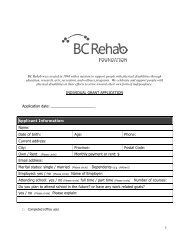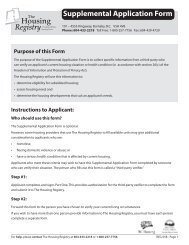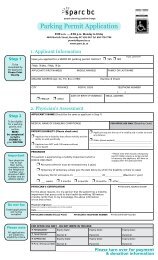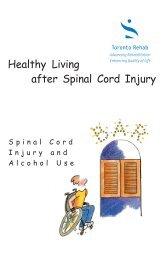Allergan Botox Brochure - SCI Information Database
Allergan Botox Brochure - SCI Information Database
Allergan Botox Brochure - SCI Information Database
Create successful ePaper yourself
Turn your PDF publications into a flip-book with our unique Google optimized e-Paper software.
Urinary Incontinence Associated<br />
with a Neurological Condition<br />
The Role of BOTOX ®
Urinary Incontinence Associated<br />
with a Neurological Condition<br />
Your physician has prescribed BOTOX ®<br />
(onabotulinumtoxinA) to help reduce<br />
leakage of urine in patients suffering<br />
from a neurological condition. 1<br />
This pamphlet has been designed to help you<br />
understand more about your condition and about<br />
BOTOX ® —what it is and how it can help you.<br />
There are questions you may want to consider<br />
when discussing BOTOX ® therapy with your doctor.<br />
Some of these may include: What does BOTOX ® do?<br />
What are its side effects?<br />
Keep this pamphlet, and use it as a reference<br />
in future should you have more questions about<br />
your treatment.<br />
2 3
Urinary Incontinence and<br />
Multiple Sclerosis<br />
Urinary Incontinence and<br />
Spinal Cord Injury<br />
Many people living with<br />
multiple sclerosis (MS)<br />
experience some form<br />
of urinary incontinence<br />
at some point in their<br />
disease progression. It’s<br />
estimated that more than<br />
80% of people living with<br />
MS have bladder control<br />
problems. 1<br />
How does spinal cord injury affect<br />
bladder control?<br />
Following a spinal cord injury, signals between<br />
the bladder and the brain may not work properly.<br />
As a result, the bladder cannot tell your brain<br />
that the bladder is full and the brain cannot<br />
allow you to voluntarily empty your bladder. 2<br />
How does MS affect bladder control?<br />
Multiple sclerosis is a disease that attacks<br />
the myelin (or “insulation”) surrounding the<br />
nerves. The result is that messages travelling<br />
between the brain and other parts of the body<br />
are interrupted and slowed, causing a kind of<br />
communication breakdown between the brain<br />
and bodily functions. This includes messages<br />
sent between the bladder and the brain. 1<br />
The most common bladder-related problem<br />
that MS patients experience is overactive<br />
bladder (OAB). For MS patients, this can<br />
cause the same kinds of symptoms that spinal<br />
cord injury patients face, such as bladder<br />
contractions and squeezing out urine<br />
without warning. 1<br />
Depending on the type of spinal cord injury,<br />
two types of bladder dysfunction can occur:<br />
• The bladder tends to hold less urine than<br />
it did before the injury, and the bladder<br />
muscles may spasm involuntarily, resulting<br />
in frequent and small urinations. 2<br />
• The bladder loses its ability to contract and<br />
is stretched out, allowing more urine to<br />
accumulate, which then causes the bladder<br />
to “overflow” or leak. 2<br />
4 5
BOTOX ® Treatment and Urinary Incontinence<br />
Associated with a Neurological Condition<br />
How often will I have to get BOTOX ®<br />
treatments?<br />
Every patient is different and will respond<br />
differently to BOTOX ® treatments. Patients may<br />
be considered for reinjection when the clinical<br />
effect of the previous injection diminishes, but<br />
no sooner than 3 months. 3<br />
NO SOONER THAN 3 MONTHS<br />
What is BOTOX ® ?<br />
BOTOX ® (also known as onabotulinumtoxinA)<br />
is a sterile form of purified botulinum neurotoxin<br />
type A complex. 3<br />
BOTOX ® is used to treat leakage of urine (urinary<br />
incontinence) due to a neurological condition in<br />
patients with multiple sclerosis and spinal cord<br />
injury who have had an inadequate response to<br />
or are intolerant of anticholinergics. 3<br />
How does BOTOX ® work?<br />
BOTOX ® works by temporarily weakening the<br />
overactive muscles that may cause the leakage<br />
of urine. Studies have shown that BOTOX ®<br />
significantly reduced leakage of urine for patients<br />
who experience neurogenic detrusor overactivity<br />
resulting from neurogenic bladder associated with<br />
a neurological condition like multiple sclerosis or<br />
spinal cord injury. 3<br />
6 7
BOTOX ® Treatment and Urinary Incontinence<br />
Associated with a Neurological Condition<br />
Dome<br />
Injection sites<br />
Base<br />
Opening of the left ureter<br />
Trigone<br />
How is BOTOX ® administered?<br />
BOTOX ® is injected with a needle into<br />
the bladder wall. Your doctor will<br />
perform the procedure. The illustration<br />
above shows the bladder wall and the<br />
areas where BOTOX ® can be injected.<br />
The recommended dose for a single<br />
treatment is 200 units of BOTOX ® . 3<br />
What happens during the procedure?<br />
Your procedure may take place in a hospital<br />
or doctor’s office. To ensure your comfort, the<br />
doctor will give you local or general anesthesia,<br />
depending on your situation. To start the<br />
procedure, your doctor will use a tool called a<br />
cystoscope, which is a special instrument used<br />
to see the interior of the bladder so that the<br />
injections can be made into the bladder muscle. 3<br />
After the procedure, you may be asked to stay<br />
in the doctor’s office for a few moments so that<br />
the doctor can see if you are able to pass urine<br />
on your own. 3<br />
8 9
BOTOX ® Treatment and Urinary<br />
Incontinence Associated with a<br />
Neurological Condition<br />
Things to Consider Before Treatment<br />
What happens after the procedure?<br />
Your doctor may give you a prescription for<br />
antibiotics in order to prevent a urinary tract<br />
infection. 3 You may also receive instructions<br />
on how to use a catheter, if you have not<br />
used one before. Your doctor will also advise<br />
you when to schedule a follow-up visit<br />
and discuss with you the timing for future<br />
procedures, once the effects of the initial<br />
BOTOX ® treatment have waned.<br />
Will I need to catheterize after<br />
receiving BOTOX ® ?<br />
BOTOX ® temporarily weakens the overactive<br />
bladder muscles, which means that some<br />
patients will need intermittent catheterization to<br />
fully empty their bladders. If you don’t already use<br />
a catheter, your health care professional can help<br />
you understand the procedure and the<br />
risks involved. 3<br />
Will I receive the same quantity<br />
of BOTOX ® each time I am treated?<br />
The recommended dose for each procedure is<br />
200 units of BOTOX ® . 3<br />
Is BOTOX ® covered by public or private<br />
insurance plans?<br />
BOTOX ® may be covered by your provincial<br />
health plan or private insurer. Speak to your<br />
physician to find out whether the cost of BOTOX ®<br />
can be reimbursed for your condition.<br />
When should BOTOX ® not be used?<br />
BOTOX ® should not be used if you: 3<br />
• Are allergic or sensitive to any of the ingredients<br />
• Have an infection in the muscles where BOTOX ®<br />
would normally be injected<br />
• Have any muscle disorders in other parts of your<br />
body, including myasthenia gravis, Lambert-<br />
Eaton syndrome, or amyotrophic lateral sclerosis<br />
• Are being treated for leakage of urine with<br />
BOTOX ® and have either a sudden onset of<br />
urinary tract infection or a sudden inability<br />
to empty your bladder (and are not regularly<br />
using a catheter)<br />
• Are not willing or able to have catheterization<br />
initiated<br />
Before starting BOTOX ® treatment, you<br />
may want to talk to your doctor or<br />
pharmacist if you: 3<br />
• Have been or are currently being treated<br />
with BOTOX ® for other conditions<br />
• Are scheduled to have surgery using<br />
a general anesthetic<br />
• Are taking or are likely to take antibiotics,<br />
especially aminoglycoside antibiotics<br />
• Are pregnant or become pregnant<br />
while taking this drug—repeated doses<br />
of BOTOX ® given to rabbits during<br />
pregnancy have caused abortion or fetal<br />
malformations<br />
• Are nursing—it is not known whether this<br />
drug is excreted in human milk, but many<br />
drugs are excreted in human milk<br />
• Have had any previous episodes of<br />
autonomic dysreflexia<br />
10 11
BOTOX ® Side Effects<br />
Frequently Asked Questions<br />
When can I stop getting<br />
BOTOX ® treatments?<br />
This is a question best answered by you and your<br />
doctor, as it depends on your individual response<br />
to BOTOX ® .<br />
Is there anything I should tell my<br />
doctor while I am being treated<br />
with BOTOX ® ?<br />
Are there side effects associated with<br />
BOTOX ® treatment?<br />
Some patients who had BOTOX ® treatment for<br />
urinary incontinence due to neurogenic detrusor<br />
overactivity reported side effects. The most common<br />
side effects included urinary tract infections,<br />
inability to empty the bladder, problems with<br />
walking, falls, muscle weakness, muscle spasm,<br />
formation of bulging pouches in the bladder wall<br />
(bladder diverticulum), fatigue, difficulty sleeping<br />
(insomnia), constipation, blood in the urine after the<br />
injection*, painful urination after the injection*, or<br />
possible uncontrolled reflex reaction of your body<br />
(e.g., profuse sweating, throbbing headache) at the<br />
time of or after the injection*. 3<br />
Seek immediate medical care if swallowing, speech,<br />
or respiratory problems arise. 3<br />
Let your doctor know if you experience any<br />
serious side effects after treatment, such as a<br />
urinary tract infection or the inability to empty<br />
your bladder. 3<br />
Tell your doctor if you experience any difficulties<br />
swallowing food while on BOTOX ® , as this could<br />
be related to the dosage. Difficulty in swallowing<br />
food, ranging from very mild to severe, can<br />
persist for two to three weeks after injection,<br />
or even longer. 3<br />
Finally, tell your doctor if you are taking other<br />
medicines, including any you have bought at<br />
your pharmacy, supermarket, or health food<br />
shop. If you are being treated for leakage of<br />
urine with BOTOX ® , tell your doctor if you are<br />
taking any anti-platelets (aspirin-like products)<br />
and/or anti-coagulants (blood thinners). 3<br />
This is not a complete list of side effects. For any<br />
unexpected effects while receiving BOTOX ® , contact<br />
your doctor or pharmacist.<br />
* Some of these common side effects may also be related to the<br />
injection procedure. 3<br />
12 13
Frequently Asked Questions<br />
Further Reading and More <strong>Information</strong><br />
How will I know that BOTOX ® is working?<br />
It may be helpful to keep an incontinence diary<br />
to track the number of incontinence episodes<br />
you experience on a weekly basis. If after a<br />
treatment with BOTOX ® you notice a drop in the<br />
number of incontinence episodes you are having<br />
on a weekly basis, this could mean that BOTOX ®<br />
treatment is working for you.<br />
Can I be treated with BOTOX ® for<br />
urinary incontinence associated<br />
with a neurological condition if I am<br />
already receiving BOTOX ® treatment<br />
for another condition?<br />
It is important that you let your doctor know that<br />
you are receiving BOTOX ® for another condition.<br />
Your doctor will determine the appropriateness<br />
and timing of treatment cycles.<br />
Can I receive BOTOX ® injections if<br />
I am taking other medications?<br />
It is possible to receive BOTOX ® injections while<br />
taking other medications, but it is important that<br />
you tell your doctor about the medicines you are<br />
taking, including any you have bought at your<br />
pharmacy, supermarket, or health food store. 3<br />
Are there any possible drug<br />
interactions with BOTOX ® ?<br />
The effect of BOTOX ® may be increased by certain<br />
types of antibiotics known as aminoglycoside<br />
antibiotics (e.g., streptomycin, tobramycin,<br />
neomycin, gentamicin, netilmicin, kanamycin,<br />
amikacin), spectinomycin, polymyxins,<br />
tetracyclines, lincomycin or any other drugs that<br />
interfere with neuromuscular transmission. 3<br />
Where can I get more information on<br />
urinary incontinence associated with<br />
a neurological condition?<br />
The following is a list of resources you can use<br />
to find more information about neurogenic<br />
detrusor overactivity.<br />
WEBSITES<br />
Canadian Urological Association:<br />
www.cua.org/patient_information_e.asp<br />
National Association for Continence (NAFC):<br />
www.nafc.org/bladder-bowel-health/neurological-disorders-2<br />
Alberta Education Initiative—Spinal Cord Injury<br />
Management Multimedia Presentation (includes slideshow<br />
chapter on neurogenic bladder): www.clrmedia.org/sci<br />
The Canadian Continence Foundation (TCCF):<br />
www.canadiancontinence.ca<br />
American Urological Association: www.urologyhealth.org<br />
IN PRINT<br />
Urinary Dysfunction and MS: A Guide for People<br />
with Multiple Sclerosis. Downloadable at:<br />
www.mssociety.ca/en/pdf/bladder.pdf<br />
Yes You Can! A Guide to Self-Care for Persons with Spinal<br />
Cord Injury. Downloadable at: www.spinalcordconnections.ca/<br />
TorontoRehab<strong>SCI</strong>/media/Test-Media-Library/PVA-doc_2.pdf<br />
14 15
Where can I get more<br />
information about BOTOX ® ?<br />
Contact your physician,<br />
or call <strong>Allergan</strong> at<br />
1-800-668-6424.<br />
REFERENCES<br />
1. National Association for Continence (NAFC) – Neurological<br />
disorders and OAB. Online. Accessed at: www.nafc.org/<br />
bladder-bowel-health/neurological-disorders-2/.<br />
2. Burns SP, Hammond MC, eds. Yes You Can! A Guide to<br />
Self-Care for Persons with Spinal Cord Injury. Fourth ed.<br />
Online. Accessed at: www.spinalcordconnections.ca/<br />
TorontoRehab<strong>SCI</strong>/media/Test-Media-Library/PVA-doc_2.pdf.<br />
3. BOTOX ® Product Monograph. <strong>Allergan</strong> Inc.,<br />
December 21, 2011.<br />
© 2012 <strong>Allergan</strong> Inc., 85 Enterprise Blvd., Suite 500,<br />
Markham ON L6G 0B5<br />
® Registered Trademark of <strong>Allergan</strong> Inc.<br />
NEURO-NDO-009 16

















